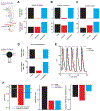A mechanism for differential control of axonal and dendritic spiking underlying learning in a cerebellum-like circuit
- PMID: 37311457
- PMCID: PMC10524478
- DOI: 10.1016/j.cub.2023.05.040
A mechanism for differential control of axonal and dendritic spiking underlying learning in a cerebellum-like circuit
Abstract
In addition to the action potentials used for axonal signaling, many neurons generate dendritic "spikes" associated with synaptic plasticity. However, in order to control both plasticity and signaling, synaptic inputs must be able to differentially modulate the firing of these two spike types. Here, we investigate this issue in the electrosensory lobe (ELL) of weakly electric mormyrid fish, where separate control over axonal and dendritic spikes is essential for the transmission of learned predictive signals from inhibitory interneurons to the output stage of the circuit. Through a combination of experimental and modeling studies, we uncover a novel mechanism by which sensory input selectively modulates the rate of dendritic spiking by adjusting the amplitude of backpropagating axonal action potentials. Interestingly, this mechanism does not require spatially segregated synaptic inputs or dendritic compartmentalization but relies instead on an electrotonically distant spike initiation site in the axon-a common biophysical feature of neurons.
Keywords: cerebellum; computational neuroscience; dendritic spikes; electric fish; neuroscience; synaptic plasticity; systems neuroscience.
Copyright © 2023 Elsevier Inc. All rights reserved.
Conflict of interest statement
Declaration of interests The authors declare no competing interests.
Figures




Comment in
-
Active sensing: How to eliminate self-generated noise.Curr Biol. 2023 Jul 10;33(13):R719-R721. doi: 10.1016/j.cub.2023.05.049. Curr Biol. 2023. PMID: 37433273
Similar articles
-
Dendritic backpropagation and synaptic plasticity in the mormyrid electrosensory lobe.J Physiol Paris. 2008 Jul-Nov;102(4-6):233-45. doi: 10.1016/j.jphysparis.2008.10.004. Epub 2008 Oct 17. J Physiol Paris. 2008. PMID: 18992811
-
Continual Learning in a Multi-Layer Network of an Electric Fish.Cell. 2019 Nov 27;179(6):1382-1392.e10. doi: 10.1016/j.cell.2019.10.020. Epub 2019 Nov 14. Cell. 2019. PMID: 31735497 Free PMC article.
-
Plasticity in an electrosensory system. III. Contrasting properties of spatially segregated dendritic inputs.J Neurophysiol. 1998 Apr;79(4):1839-57. doi: 10.1152/jn.1998.79.4.1839. J Neurophysiol. 1998. PMID: 9535952
-
Physiology of electrosensory lateral line lobe neurons in Gnathonemus petersii.J Exp Biol. 1999 May;202(Pt 10):1301-9. doi: 10.1242/jeb.202.10.1301. J Exp Biol. 1999. PMID: 10210670 Review.
-
Synaptic plasticity in the mormyrid electrosensory lobe.J Exp Biol. 1999 May;202(Pt 10):1339-47. doi: 10.1242/jeb.202.10.1339. J Exp Biol. 1999. PMID: 10210674 Review.
Cited by
-
Connectome analysis of a cerebellum-like circuit for sensory prediction.bioRxiv [Preprint]. 2025 Jul 3:2025.07.03.662989. doi: 10.1101/2025.07.03.662989. bioRxiv. 2025. PMID: 40631126 Free PMC article. Preprint.
References
-
- Spruston N, Schiller Y, Stuart G, and Sakmann B (1995). Activity-dependent action potential invasion and calcium infulux into hippocampal CA1 dendrites. Science 268, 297–300. - PubMed
-
- Stuart GJ, and Sakmann B (1994). Active propagation of somatic action potentials into neocortical pyramidal cell dendrites. Nature 367, 69–72. - PubMed
-
- Hausser M, Stuart G, Racca C, and Sakmann B (1995). Axonal inhibtion and active dendritic propagation of action potentals in susbstantia nigra neurons. Neuron 15, 637–647. - PubMed
Publication types
MeSH terms
Grants and funding
LinkOut - more resources
Full Text Sources

